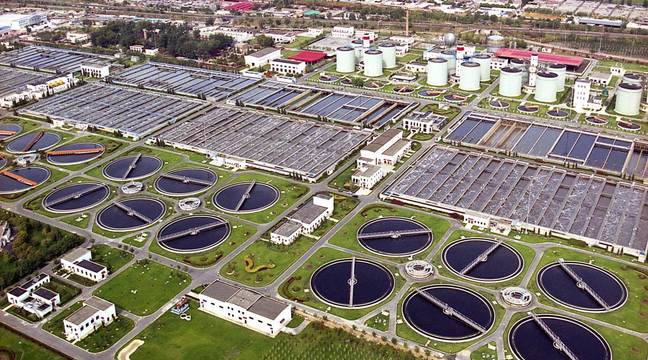
当前课程知识点:Water and Wastewater Treatment Engineering: Biochemical Technology > Chapter 2 Activated sludge process > Section 2.5 Principle, calculation and equipment of aeration > Section 2.5.2 Principle, calculation and equipment of aeration(2)
返回《Water and Wastewater Treatment Engineering: Biochemical Technology》慕课在线视频课程列表
返回《Water and Wastewater Treatment Engineering: Biochemical Technology》慕课在线视频列表
同学们好,我们来看曝气过程的第二个环节
即实际供氧与标准供氧量之间的差别
以及如何进行两者之间的换算,所谓的标准氧转移速率
是指在20度,这个当然是摄氏度,和一个标准大气压的条件下
在脱氧清水中间对某种曝气设备进行充氧速率的测定
所测得的氧的转移速率,一般我们用R_0来表示
它的单位是kgO2/h,而实际的氧转移效率是指以城市废水
或者是工业废水为对象,在当地的大气压和当地的实际的水温下
对同样的曝气设备进行测定,而所得到的
就是成为实际的氧转移速率
一般用R来表示,单位也是kgO2/h
我们可以想象在二者之间,一定会有较大的差别
主要还是由于在实际的条件下,废水中间的多种因素
可能会对这个氧气的传递,产生不利的影响
对于同一个曝气设备来说,在一般情况下
R_0都会大于R,这张表就给出了实际条件下
主要影响氧转移速率的几个因素,首先我们来看
与标准状态下最大的不同,实验所用的水质上是有很大的差别
标准状态下,是脱氧后的清水,但在实际状态下
则是含有多种不同成分,浓度高低不一的废水或者是污水
水质的不同,对于曝气的传递过程会有严重的影响
主要表现在两个方面,一是降低这个氧的总转移系数
通常,采用乘以系数α的方式表示废水水质的变化
导致K_La的减少的程度,通常α约在0.8到0.85之间
第二,是水质的变化
也同样会降低相应条件下的饱和溶解氧浓度Cs
同样,也采用乘以系数β的方法来表示
但其影响程度相对较低,也就是说
β一般是在0.9到0.97之间,第二个主要因素就是水温
标准条件下的水温,我们设定为20℃,但实际废水的水温
可能会有很大的不同,即使是在同一个污水处理厂
由于季节的不同,水温可能也会有很大的差别
水温对氧转移速率的影响,主要表现在两个方面
一个是,会影响氧的总转移系数,即K_La
一般可以用这个公式来计算水温对KLa的影响,从这个公式
可以看出,水温越高,K_La越大,越有利于氧气的转移
第二是会影响水中的饱和溶解氧浓度Cs
一般来说,水温越高,固体物质在水中的溶解度
会相应增加,在一个标准大气压下
在蒸馏水中的饱和溶解氧浓度,随温度的变化
如这个图所示,可以看出在水温接近零度时
饱和溶解氧浓度,等于14.62㎎/L
而10度时,Cs等于11.33㎎/L,20度时,等于9.17mg/L
30度时是7.63mg/L,第三个影响氧转移速率的因素
是气压,首先是当地的气压
会影响饱和溶解氧浓度Cs值,根据气体溶解的亨利定律
在某个实际大气压p的条件下,饱和溶解氧浓度Cs(p)
与标准大气压下的饱和溶解氧浓度Cs(标准)之间
可以用这个公式来表示它们之间的关系
在多数情况下,实际大气压与标准大气压之间
并没有很大的差别,除非在一些高海拔的地区
因此的话,有时也会用系数ρ来代替实际大气压
与标准大气压之间的比值,所以上面这个公式
就可以写成这样的一个公式,通常情况下
ρ约等于1,但是对于鼓风曝气系统来说
其曝气头,通常会被安装在水面下一定的深度
在普通活性污泥法的曝气池中间,这个深度
通常是4.0到4.5m,所以,我们可以看出
当空气的气泡刚刚从曝气头中释放出来的时候
即这个气泡一,其中它的氧气的含量
仍然是跟空气一样,约为21%,但是其压力
就应该等于当地大气压加上水深所造成的压力之和
因此,我们可以假设与其相对应的饱和溶解氧浓度
为Cs1,而当这个气泡逐渐上升到水面,在即将离开液面
进入大气之前的一瞬间,即图中所示的气泡二
它的压力与当地的大气压,是相等的
但是,其中氧气的含量,由于在其上升的过程中间
有一部分,已经溶解到水中,所以,它氧气的含量已经减少了
我们可以认为当气泡从曝气池底部逐渐上升的过程中间
其压力的下降,以及氧含量的下降,均与水深
呈线性关系,因此,我们就可以用这个公式来计算Csm
即Csm,等于Cs1和Cs2的平均值,其中
Cs1可以用这个公式来进行计算
Cs2可以用这个公式来进行计算,其中Pb是指曝气头安装处的压力
因此,我们现在就可以来看看
标准氧转移速率与实际氧转移速率之间的关系
首先,假设在标准大气压下
在一个装有体积为V的脱氧清水的水池中间
我们安装曝气头进行曝气,来测试计算出
其标准的氧转移速率,即R_0,根据前面已经介绍过的知识
可以知道,R_0可以用这个公式来表达
因为是在脱氧清水中,进行的测试,所以其C_l等于0
因此R_0就可以等于K_La(20)乘以Csm(20)再乘以V
对于水温为T,当地大气压为p的条件下
如果仍采用上述同样的曝气头,安装在同样水深下
对于某种实际的废水进行曝气,此时的氧转移速率
就可以被称为,实际的氧转移速率
实质上就是前面说的R,显然,与R_0相比
R会被大打折扣,即可以用这个公式来进行表达
上式中的C_l是指曝气池混合液中间的溶解氧浓度
一般是1到2mg/L,如此可见R_0与R的比值
就如这个公式所示,一般情况下R_0比R
会等于1.3到1.6之间,或者反过来说R比R_0
一般等于0.63到0.77,这说明对于同样的曝气设备
在标准状态下的氧转移速率,是实际条件下的1.3到1.6倍
因此当我们在设计曝气池时
如果已经通过计算确定了实际的需氧量,或者说是供氧速率
或者我们有的时候也会称为氧转移速率R
就可以通过这个公式,计算出应该配备的标准条件下的供氧速率
即R_0是多少,再通过跟曝气设备生产厂家的咨询与确认
就可以为你设计的曝气池进行选购
与实际需氧量R相比,已经放大了的供氧速率为R_0的曝气设备
确保了,能够在实际运行过程中间
能够保证供氧的要求
对于我们图中所示的这样一个曝气系统来说
为了正确地选择鼓风机
还需要在计算得到的标准供氧速率的基础上
计算出具体所需要的供气量,对于供气量的计算
我们首先来看氧转移效率E_A的定义
E_A是指在标准状态下通过鼓风曝气系统转移到混合液中间的氧量
占总供氧量的百分比,如果假设通过鼓风机空气管道和曝气头
向水中供入的总氧量为Oc,单位当然是kgO2/h
则根据上式的定义,可知道E_A等于R_0除以Oc
如果用Gs来表示鼓风机的供气量,单位是m3/h
那我们就会看到, Oc与Gs的关系,可以用这个公式来表示
因此,在通过计算求得曝气池所需要的标准供氧量R_0以后
又通过了产品的对比,确定了曝气设备,并且得知了
它的氧的转移效率EA以后,就可以通过这个公式来
计算得到鼓风机所需要的供气量Gs,对于鼓风曝气系统来说
各种曝气装置的E_A值,是制造厂家通过在脱氧清水中间
通过充氧实验而测试得到的,一般会随着这个产品
向用户来提供,因此的话,有了这个E_A以后
我们就能够方便地利用这个公式,计算出这个供气量Gs值
前面所介绍的关于供气量的计算,是与鼓风曝气系统有关
但是对于机械曝气系统来说,由于其曝气设备
是安装在水面附近,而且,一般也无法计算其供气量
所以的话,对于机械曝气系统来说
就可以直接利用这个公式,来计算出它的实际供氧量R_0
对于机械曝气系统,有时候也把这个R_0称为它的充氧能力,单位是kgO2/h
而设备厂家,会向用户提供其设备在标准状态下的充氧能力
即R_0值,因此的话,就可以根据这个计算得到的R_0
就可以进行设备的选型和选择,通过前面的讲述
我们可以简单总结一下,针对两种不同的曝气方式
即鼓风曝气系统和机械曝气系统,它曝气系统的设计计算
有这样的一般的程序,对于鼓风曝气系统来说,我们首先求得
需氧速率,根据需氧速率与供氧速率需要相等的原则
我们就知道了实际的这个供氧速率R,根据这个公式
求得标准氧的转移速率R_0,然后继续利用这个公式求出
供气量,随后,我们就要设法求得鼓风机所需要的
出口风压,根据管路系统的沿程阻力、局部阻力
以及,曝气头安装位置的静水压力,再加上一定的
余量,就得到所要求的鼓风机的最小风压,最后
我们根据风量和风压,来选择合适的风机
但是对于这个机械曝气来说的话,我们首先,也是求得
它的需氧量,同样,也根据需氧量与供氧量需要相等的
原则,我们就知道了,它的实际的供氧量
用这个公式,计算出它的标准的供氧速率R_0
根据R_0,我们就可以直接选择机械曝气设备
好,我们在前面,已经介绍了这个曝气系统的计算方法
下面,我们简单的来介绍一下我们日常使用的曝气设备
首先,我们来看曝气装置的分类,曝气装置
我们称为空气扩散装置,是活性污泥系统的最重要的一个设备
根据曝气方式的不同,可以分为鼓风曝气装置,或者是机械
或者是表面机械曝气装置,这两种
对于曝气设备来说,我们有三个指标来衡量它的技术性能指标
第一个,是我们前面已经提过的氧的利用率
或者有的时候称为氧的转移效率E_A,它是特别的指
通过鼓风曝气系统转移到混合液中间的氧占总供氧量的百分比
第二个指标,是充氧能力,主要
是指表面机械曝气装置,在单位时间内,转移到
混合液中间的氧的量,单位是kgO2/h
第三个性能指标,称为动力效率,指Ep
这是针对鼓风曝气系统和机械曝气系统都可以来用一个性能指标
它是指每消耗一度的电,或者说是一千瓦时的电
能够转移到混合液中间的氧气的量
单位是kgO2/(kW·h),关于这个鼓风曝气装置
我们来看一看从前面已经介绍过的鼓风曝气系统来看的话
它主要由鼓风机、空气的输送管道、以及,曝气装置所组成
鼓风曝气的装置,一般我们可以分为这样几类
一类,是称为微气泡或者是小气泡
正常在活性污泥的曝气池中间,使用的最多的就是微孔曝气头
除此之外我们当然还有其他的像中气泡型的,大气泡型的
以及,水力剪切型和水力冲击型
这些图片分别介绍了不同类型的这个曝气头
对于机械曝气装置来看的话,它的曝气原理,跟鼓风曝气是有一定的差别
简单来说,它是有这样三个环节,第一个
是通过机械曝气装置,低速地在水面的转动
能够形成水跃,实际上是指曝气机转动的时候
表面的混合液不断地从周边被甩向四周,形成水跃
液面被强烈的搅动而且有一部分空气被卷入
第二个作用,就是提升,曝气机具有很好的提升作用
它们能够使混合液连续的上下循环流动,不断地更新
气液交界面积,强化气液的接触,第三,是负压吸气
曝气器的转动,使其在一定的部位会形成负压
这个负压就会吸入空气,加强
空气跟混合液的混合接触,促进供氧,对于表面曝气装置
来说,简单来说的话,可以分成两大类,一类
是竖轴式的表面曝气装置,一类,是横轴式表面曝气装置
对于竖轴式的表面曝气装置,我们主要有这四种类型
一种,我们称为泵型的叶轮曝气器,一种称为
K型叶轮曝气器或者说是双曲线型的叶轮曝气器,还有一种是
倒伞型叶轮曝气器,第四种,是平板型的叶轮曝气器
这些图片,分别说明了这四种类型的主要的一些代表的曝气器
第二种,是横轴式的机械曝气器
主要,实际上有两种,一种,我们称为曝气转刷
一种,我们称为曝气转盘,有时候曝气转盘也会称为曝气转碟
这些曝气设备,主要是用于氧化沟
氧化沟我们后面会来做仔细的介绍,它实际上是一种活性污泥法
这些曝气装置,能够方便地进行调节,维护也比较简单
而且动力效率比较高,这些图片,给大家展示的
就是曝气转刷和曝气转盘或者是曝气转碟
这节的内容就到这,谢谢大家
-Section 0.1 Development Status of Wastewater Treatment Process
--Section 0.1 Development Status of Wastewater Treatment Process
-Section 0.2 Typical Processes of Wastewater Biological Treatment
--Section 0.2 Typical Processes of Wastewater Biological Treatment
-Section 1.1 Principles of wastewater aerobic biological treatment
--1.1 Principles of wastewater aerobic biological treatment
-Section 1.2 Principles and determination of wastewater biodegradability
--1.2 Principles and determination of wastewater biodegradability
-Section 1.3 Principles of wastewater anaerobic biological treatment
--Section 1.3.1 Principles of wastewater anaerobic biological treatment(1)
--Section 1.3.2 Principles of wastewater anaerobic biological treatment(2)
-Section 1.4 Principles of wastewater biological nitrogen removal
--Section 1.4 Principles of wastewater biological nitrogen removal
-Section 1.5 Principles of wastewater biological phosphorus removal
--Section 1.5 Principles of wastewater biological phosphorus removal
-Chapter 1 Homework
-Section 2.1 Basic concept of activated sludge process
--Section 2.1.1 Basic concept of activated sludge process
--Section 2.1.2 Basic concept of activated sludge process
-Section 2.2 Growth rule of activated sludge and its application
--Section 2.2 Growth rule of activated sludge and its application
-Section 2.3 Running mode of activated sludge process
--Section 2.3.1 Running mode of activated sludge process(1)
--Section 2.3.2 Running mode of activated sludge process(2)
-Section 2.4 Kinetics of active sludge process
--Section 2.4.1 Kinetics of active sludge process(1)
--Section 2.4.2 Kinetics of active sludge process(2)
--Section 2.4.3 Kinetics of active sludge process(3)
--Research and Development of Kinetic Model of Activated Sludge Process
-Section 2.5 Principle, calculation and equipment of aeration
--Section 2.5.1 Principle, calculation and equipment of aeration(1)
--Section 2.5.2 Principle, calculation and equipment of aeration(2)
-Section 2.6 Designing of activated sludge process
--Section 2.6 Designing of activated sludge process
-Section 2.7 Operation and management of active sludge process
--Section 2.7.1 Operation and management of active sludge process (1)
--Section 2.7.2 Operation and management of active sludge process (2)
-Chapter 2 Homework
-Section 3.1 Basic principle of biofilm
--Section 3.1 Basic principle of biofilm
-Section 3.2 Biofilter process
--Section 3.2.1 Biofilter Process (1)
--Section 3.2.2 Biofilter process (2)
--Section 3.2.3 Biofilter process (3)
-Section 3.3 Biodisk process
-Section 3.4 Biological contact oxidation process
--Section 3.4 Biological contact oxidation process
-Section 3.5 Aerobic biological fluidized bed process
--Section 3.5 Aerobic biological fluidized bed process
-Chapter 3 Homework
-Section 4.1 Oxidation ditch process
--Section 4.1 Oxidation ditch process
-Section 4.2 A-B process
-Section 4.3 SBR process
-Section 4.4 MBR process
-Chapter 4 Homework
-Section 5.1 Overview and characteristics of development of anaerobic biological treatment
--Section 5.1 Overview and characteristics of development of anaerobic biological treatment
-Section 5.2 Anaerobic digester
--Section 5.2 Anaerobic digester
-Section 5.3 Anaerobic contact process and anaerobic filter process
--Section 5.3 Anaerobic contact process and anaerobic filter process
-Section 5.4 UASB process
-Section 5.5 Other anaerobic biological treatment process
--Section 5.5 Other anaerobic biological treatment process
-Section 5.6 Operation management of anaerobic biological treatment process
--Section 5.6 Operation management of anaerobic biological treatment process
-Chapter 5 Homework
-Section 6.1 Introduction
-Section 6.2 Biological nitrogen removal process and technology
--Section 6.2 Biological nitrogen removal process and technology
-Section 6.3 Biological phosphorus removal process and technology
--Section 6.3 Biological phosphorus removal process and technology
-Section 6.4 Simultaneous nitrogen and phosphorus removal process
--Section 6.4 Simultaneous nitrogen and phosphorus removal process
-Chapter 6 Homework
-Section 7 Natural biological treatment process
--Section 7 Natural biological treatment process
-Chapter 7 Homework
-Section 8.1 Source, nature and treatment of sludge
--Section 8.1 Source, nature and treatment of sludge
-Section 8.2 Sludge thickening and digestive stability
--Section 8.2 Sludge thickening and digestive stability
-Section 8.3 Sludge conditioning, dehydration and incineration
--Section 8.3 Sludge conditioning, dehydration and incineration
-Chapter 8 Homework
-Section 9 Wastewater Discharge and Reuse
--Section 9 Wastewater Discharge and Reuse
-Chapter 9 Homework

